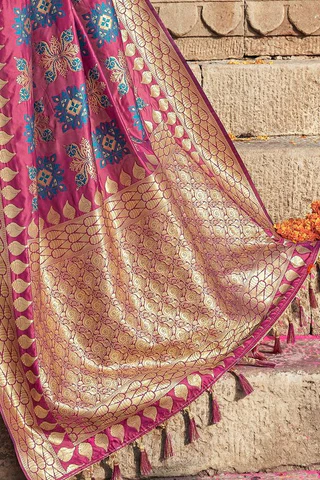The Best All-Season Natural Silks of India
India is a land of remarkable diversity and heart-warming vivacity. In its mesmerising milieu of clothing styles and colourful attires, the silk of India stand out with their soft textures and aesthetic appeal. The fabric is used to create a diverse range of textiles that cater to the clothing desires of all categories of people.
With its shimmering appearance and smooth texture, silk has been enticing Indians for a long time now. So much so that today India ranks as the largest consumer of this fabric. When it comes to the types of silk fabric produced in India, every region in the country boasts of its unique kind. Such fabrics are woven from different kinds of natural silk produced in India. In this article, we provide you a glimpse of the varieties of natural silks found in India and the types of silk fabric weaved from them.
Muga Silk
An exclusive specialty of Assam, the Muga silk is one of the rarest silks produced in the world. It is known for its shimmering glossy texture and extreme durability. This silk is produced by the larva of a silkworm named Assam silkmoth (Antheraea assamensis).

Muga silk is considered to be among the strongest natural fibres and has a distinct natural yellowish-golden tint. One of the most expensive varieties of silk produced in the world, Muga silk is used to make mekhela chador (traditional Assamese wear), sarees, kurtas, stoles, etc. The traditional motifs and intricate patterns weaved on the silk fabric add to its beauty and demand. The uniqueness of the fabric lies in the fact that it increases its lustre with age and after every wash. Muga silk is also known for its longevity. It is often remarked that a muga silk fabric lives longer than its wearer.
Eri Silk
Eri silk, also known as Endi or Errandi silk is one such variety of silk. It is processed from the open-ended cocoons of the domesticated silkworms known as Samia ricini and Philosamia ricini, which are native to Assam. Since the silk is obtained without killing the silkworm, it is also referred to as Ahimsa silk or peace silk. This is one of the reasons that the Buddhist monks of India, China, Nepal, and Japan prefer this silk of non-violent origin.

Eri silk is distinguished by it’s typical dense and coarse texture, matt appearance, and dull golden yellow sheen. Eri is not as expensive as the other categories of silks produced. So, it is also known as the poor person’s silk. Valued for its strength and thermal insulating properties, this silk is mainly used to make shawls, quilts, wraps, bedspreads, etc. Nowadays even sarees are being produced out of this silk.
Tasar Silk
Tasar silk, alternatively spelt as Tassar, Tussar, Tussah, Tussur, Tusser, or Tussore silk, is also known as Kosa silk in Sanskrit. It is primarily produced in the states of West Bengal, Bihar, Odisha, Jharkhand, Chattisgarh, Madhya Pradesh, and Maharashtra. The Oak Tusar silk is a finer variety of the Tasar silk that is also produced in India. Tasar silk is generated from the larvae of the silkworm Antheraea mylitta that live in wild forests. This has earned the silk the name of the ‘wild silk’. India occupies the second position as a producer of Tasar silk and is the exclusive producer of Indian Tussar.

Tasar silk stands out with its rich texture and deep gold sheen. Sarees made from this silk are its most famous produce, though it is also used to generate fabrics for furnishing, dupattas, and dresses.
Bhagalpuri Silk
Bhagalpur, a small town in Bihar, goes by the moniker of the ‘Silk City’ and is famous for its Bhagalpuri silk sarees. The intrinsic artwork reflected in these sarees are stunning, to say the least. Apart from the striking motifs and designs, the multi coloured silk threads used to weave these sarees also lend them a vibrant look and feel.

Kosa Silk
Kosa silk, a variety of Tasar silk, is produced in Chhattisgarh. Sarees made from Kosa silk are admired for their unique patterns and artistic designs inspired by tribal stories and nature. The classic Kosa silk sarees are characterised by their dull golden hues. Natural dyes are used to add colour to the kosa silk yarns to create colourful sarees. Apart from sarees, Kosa silk is used to make lehenga, dhoti, kurta, etc.

Mulberry Silk
The most popular and renowned variety of silk produced in India is the mulberry silk. The states of Tamil Nadu, Karnataka, Andhra Pradesh, West Bengal, and Jammu and Kashmir are recognised as the main producers of this silk. This silk is produced by the domesticated silkworm called Bombyx mori.

Mulberry silk is known for its exquisite quality. It is one of the strongest natural fibres in the world. That is why textiles produced from pure Mulberry silk are highly durable. The silk attracts attention due to its fine texture and lustrous sheen that can enhance the beauty of any attire designed from it. Due to the richness of the material, sarees weaved from Mulberry silk are in high demand. This silk is also used to create evening gowns, dress materials, fabric for furnishing, dhotis, kurtas.
Banarasi Silk
Banarasi silk or Benarasi silk is one of the finest variants of silk produced in India. Primarily weaved in the holy city of Varanasi or Banaras in Uttar Pradesh, this silk attracts attention due to the zari and brocade work in gold and silver thread on the fine fabric. Benarasi silk sarees are known all over the world for their splendour and exquisiteness. With their vibrant colours, intricate designs, and immaculate embroidery in gold and silver threads, a Benarasi saree often finds a place of pride in the trousseau of an Indian bride.

Kanjeevaram Silk
Kanjeevaram silk traces its origin to the Kancheepuram town in Tamil Nadu. Made from pure mulberry silk threads, this silk is renowned for its strength, lustrous shine, and grandeur. Kanjeevaram silk sarees are among the most popular silk sarees in the world. With their rich hues, captivating broad borders, and mesmerising designs, this silk has been enhancing the beauty of the Indian women since long. The specialty of this saree is that the border and the body are woven separately and joined later.

Baluchari Silk
A trademark of West Bengal, the Baluchari silk derives its name from the Baluchar village where this rich weaving tradition originated more than 200 years ago. The unique feature of a Baluchari silk saree is the elaborate representation of mythical scenes on its pallu and borders with silk threads.

Chanderi Silk
This silk comes from Chanderi, a small town in Madhya Pradesh. The traditional Chanderi silk sarees entice wearers with their amazing texture, luxurious feel, light weight, and soft pastel hues. Strands of mulberry silk weaved with golden threads and ornamented with unique motifs or buttis are what makes these sarees such prized possessions. Chanderi silk is also used for producing attractive dress material.

Mysore Silk
Mysore silk from Karnataka is known for its radiance, durability, and non-crush quality. The most distinctive feature of Mysore silk sarees is the pure gold zari work done on the single-toned sarees with golden borders. Mysore silk is used to create lovely silk stoles, shawls, kurtis, dhotis, scarfs, and pyjama kurtas.

Pochampally Silk
The Bhoodan Pochampally town in Telangana produces the exotic Pochampally silk sarees. These sarees are renowned for the intricate motifs and amazing designs reflected on the fine Pochampally fabric through ikat style of dyeing. It is the exceptional blend of silk and cotton along with the bright colours that make these sarees truly unique.
Konrad Silk
Usually designed in checks or stripe patterns, the Konrad silks of Tamil Nadu are light weight sarees. The design-embellished borders and the nature-inspired motifs highlight the beauty of these silk sarees.

Chettinad Silk
The southern town of Chettinad in Tamil Nadu is recognised as the producer of the Chettinad silk. Chettinad sarees are defined by an extensive use of colours and patterns. Bold stripes and checks are the most common design patterns found in the Chettinad silk sarees.

Patola Silk
The Patola silk is a gift to the world from Patan in Gujarat. The double ikat woven Patola silk saree is a tie and dye beauty. Renowned for their style and colourful designs, the Patola silk sarees can take up to one year to be created.

Ikat Silk
From the coastal land of Odisha or Orissa comes the lovely Ikat silk sarees. This weave is created using a tie and dye method which lends the saree its unique look and feel. Typical design motifs on an Ikat silk include animals, birds, fish, beads of rudraksha, temple tops, and geometric patterns. A remarkable feature of this saree is that it reflects the same colourful motifs and patterns on both sides.

Come visit us at www.designcart.com to get hold of beautiful and elegant silk fabrics at your finger tips. The huge array of collection is going to sweep you off your feet and will be your best pick to create your very own timeless pieces. Happy Shopping!






